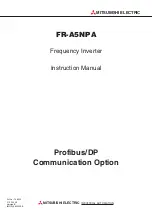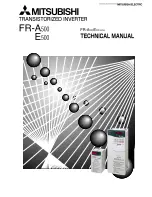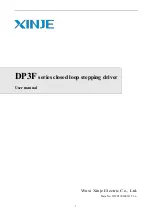
Chapter 4 Parameters
VFD-EL-W
4-81
Command message:
Response message:
‘7’
‘7’
‘0’
‘0’
LRC Check
‘7’
LRC Check
‘7’
‘1’
‘1’
END
CR
END
CR
LF
LF
RTU mode:
Command message:
Response message:
ADR
01H
ADR
01H
CMD
08H
CMD
08H
Data
00H
Data
00H
00H
00H
Data
17H
Data
17H
70H
70H
CRC CHK Low
8EH
CRC CHK Low
8EH
CRC CHK High
0EH
CRC CHK High
0EH
4. CRC (Cyclical Redundancy Check) is calculated by the following steps:
Step 1:
Load a 16-bit register (called CRC register) with FFFFH.
Step 2:
Exclusive OR the first 8-bit byte of the command message with the low order byte of the 16-bit
CRC register, storing the result in the CRC register.
Step 3:
Examine the LSB of CRC register.
Step 4:
If the LSB of CRC register is 0, shift the CRC register one bit to the right with MSB zero filling, then
repeat step 3. If the LSB of CRC register is 1, shift the CRC register one bit to the right with MSB zero
filling, Exclusive OR the CRC register with the polynomial value A001H, then repeat step 3.
Step 5:
Repeat step 3 and 4 until eight shifts have been performed. When this is done, a complete 8-bit
byte will have been processed.
Step 6:
Repeat step 2 to 5 for the next 8-bit byte of the command message. Continue doing this until all
bytes have been processed. The final content of the CRC register is the CRC value. When transmitting the
CRC value in the message, the upper and lower bytes of the CRC value must be swapped, that is the
lower order byte will be transmitted first.
The following is an example of CRC generation using C language. The function takes two arguments:
Unsigned char* data
a pointer to the message buffer
Unsigned char length
the quantity of bytes in the message buffer
The function returns the CRC value as a type of unsigned integer.
Unsigned int crc_chk(unsigned char* data, unsigned char length){
int j;
unsigned int reg_crc=0xFFFF;
while(length--){
reg_crc ^= *data++;
for(j=0;j<8;j++){
if(reg_crc & 0x01){ /* LSB(b0)=1 */
reg_crc=(reg_crc>>1) ^ 0xA001;
}else{
reg_crc=reg_crc >>1;
}
}
}
return reg_crc;
}
Summary of Contents for VFD-EL-W Series
Page 7: ...v This page intentionally left blank ...
Page 21: ...Chapter 1 Introduction VFD EL W 1 14 This page intentionally left blank ...
Page 34: ...Chapter 2 Installation and Wiring VFD EL W 2 13 This page intentionally left blank ...
Page 42: ...Chapter 3 Keypad and Start up VFD EL W 3 8 This page intentionally left blank ...
Page 150: ...Chapter 4 Parameters VFD EL W 4 108 This page intentionally left blank ...
Page 152: ...Chapter 5 Troubleshooting VFD EL W 5 2 5 1 Over Current oc ...
Page 153: ...Chapter 5 Troubleshooting VFD EL W 5 3 5 2 Over Voltage ov ...
Page 154: ...Chapter 5 Troubleshooting VFD EL W 5 4 5 3 Low Voltage Lv ...
Page 155: ...Chapter 5 Troubleshooting VFD EL W 5 5 5 4 Overheat oH1 ...
Page 156: ...Chapter 5 Troubleshooting VFD EL W 5 6 5 5 Overload oL ...
Page 157: ...Chapter 5 Troubleshooting VFD EL W 5 7 5 6 Keypad Display is Abnormal 5 7 Phase Loss PHL ...
Page 158: ...Chapter 5 Troubleshooting VFD EL W 5 8 5 8 Motor Does Not Run ...
Page 159: ...Chapter 5 Troubleshooting VFD EL W 5 9 5 9 Motor Speed Cannot be Changed ...
Page 163: ...Chapter 5 Troubleshooting VFD EL W 5 13 This page intentionally left blank ...
Page 179: ...Appendix A Specifications VFD EL W A 6 This page intentionally left blank ...
















































